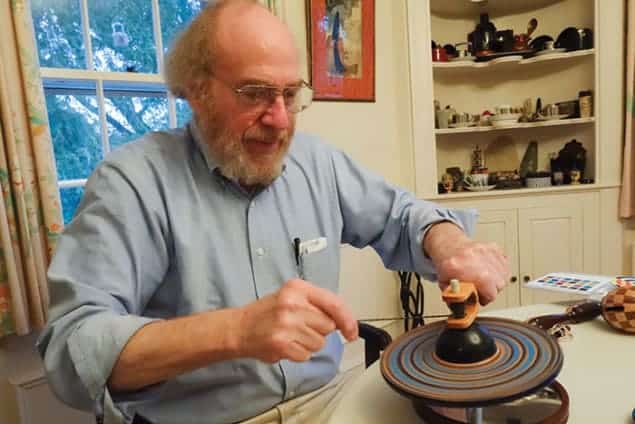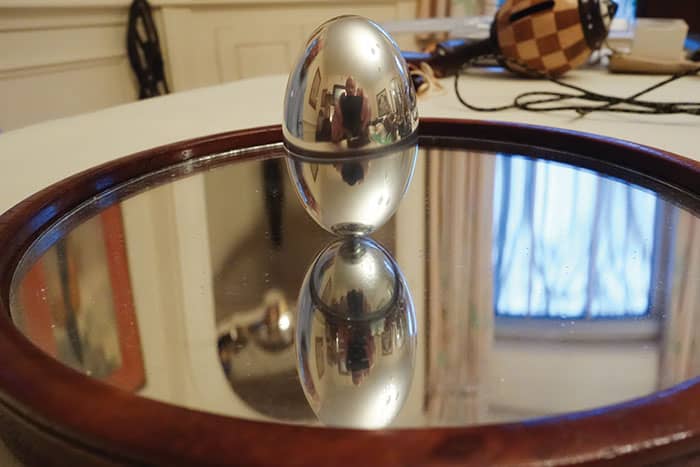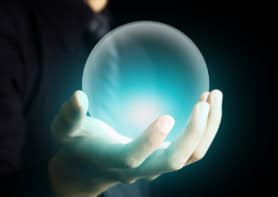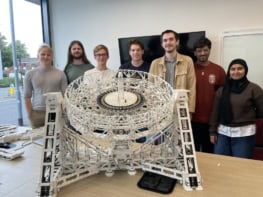Robert P Crease meets Kenneth Brecher, who loves tops

Picking a top from among the three dozen in front of him, Kenneth Brecher gives it a quick twist with his fingers and lets it fall on his dining-room table. The little symmetrical object bounces once, then whirls furiously, all the while standing still and almost motionless on point. “I love tops!” he cries. Seeing the beautiful little performance – the top utterly silent yet responsive to the slightest bump, gust or other perturbation – it’s impossible not to share his enthusiasm.
Brecher recently retired after 35 years as a professor of astronomy and physics at Boston University in the US. For two decades, he designed hands-on, educational optics experiments and demonstrations thanks to a National Science Foundation-sponsored effort called Project LITE: Light Inquiry Through Experiments. One by-product of this project was his interest in kaleidoscopes, which I covered in a column last year (“Meet the kaleidoholics”). Another, via a roundabout route, turned into a passion for tops.
Ahead of my visit, Brecher filled his dining-room table with varieties of tops drawn from his collection of hundreds. Some are handcrafted, some machined. A few are of Brecher’s own design.
“That’s called a finger top,” he says, pointing to the one still spinning on the table. “This one’s a supported top,” he adds, indicating one that you start by holding it in a frame and pulling a string. “Whip tops” are kept going by lashing them.
Brecher picks up a hollow top whose surface is chiselled with horizontal and vertical ridges. It looks like a hand grenade. “Guess what this does!” he asks. I wonder if it makes a noise, and as Brecher sets it whirling, it duly emits a low, owl-like sound. “It’s a humming top,” he says. “Wait till you hear the resonant frequency!” A moment later, as it slows, the deep sound is joined by a haunting, higher-pitched overtone.
Brecher picks up a jar lid that he has turned into a top and spins it. “Look at the dynamics! It spins, wobbles and spins again,” he says, delighted. “I call it spobbling!”
From Tutankhamun to Maxwell
Tops are among the oldest and most universal kind of toys, with nearly all cultures having them. Toy tops were among the contents of Tutankhamun’s tomb dating from 1300 BC, while a whip top appears in a Hittite bas-relief from about 800 BC. Nearly all cultures, too, have found tops to have symbolic meanings.
Pieter Bruegel the Elder included them in his Children’s Games painting of 1560. Franz Kafka wrote a short story, “Der Kreisel”, in which a philosopher grows frustrated because, trying to understand a top, it stops spinning the moment he grabs it, symbolizing the ineffability of life. Hans Christian Andersen wrote a fairy tale – “Toppen og bolden” – about the unrequited love of a top for a ball, while Georges Bizet even devoted the piano composition La Toupie to a top.
More recently, the protagonist of the 2010 film Inception uses a top to distinguish between dreams and reality. If the top spins continuously, he knows he’s dreaming, while if it eventually falls over he knows he’s awake. Film critics had a field day discussing the significance of the fact that at the conclusion he spins the top, and the film ends without showing whether the top falls or not. One of the simplest of physical devices, a top usually consists of a mass symmetrically arranged about a spindle with a point at one end. When spun and given sufficient angular momentum, it whirls about that point without falling over. But despite tops having existed for so long, it is only relatively recently that scientists have begun to explain and exploit their physical properties. Indeed, their dynamics are still not entirely clear.
The study of spinning tops started in the 18th century with the mathematician Leonhard Euler (1707–1783). He wrote several papers on the subject, framing their motions in terms of angles of orientation now called Euler angles. Using these angles, most top dynamics can be described in terms of three basic motions: spin, precession and “nutation” – or the wobbling of the rotational axis.
Serious experimental research into tops had to wait till the 19th century, however, thanks to the curiosity of the young James Clerk Maxwell. One of his professors in Edinburgh was interested in vision, and used tops to create visual perception illusions. Soon afterwards, when Maxwell went to Cambridge, he devised his own colour-mixing disc, initiating the quantitative study of colorimetry.
A few years later, when Maxwell was back in Scotland as a professor in Aberdeen, he designed and built a special top that puts the support at the centre of mass so there’s no net gravitational torque and the top can be spin oriented in any direction. He also put in set screws that could be adjusted to raise or lower the centre of mass. “That turned the top into a highly sensitive instrument,” Brecher says, “allowing him to measure its responses to external influences.”
Having bought a replica of Maxwell’s original device, Brecher picks it off the table and points out the support, which lies inside a mushroom-like cap. “This is the most beautifully designed top ever!”
Gyroscopes
The theory of tops was given further impetus in the 19th century by the development of gyroscopes. These consist of a freely rotating central mass (a sphere or disc) on a mount, or “gimbal”, that holds this mass steady even when the support is tilted.
The German astronomer Johann Bohnenberger was the first to discover the gyroscope effect, in which the axis of a rotating object can maintain the same direction despite the movement of its support, and in 1817 he discussed in print devices he had built exhibiting it. A few decades later the French physicist Leon Foucault gave gyroscopes their name and used them to demonstrate the rotation of the Earth. Now they are all over, from inside mobile phones (where they track orientation) to outer space. “Gravity Probe B was the world’s most expensive gyroscope,” Brecher says. “Everyone in the US has spent $3 on it.”
Top theory was further advanced by the mathematician Felix Klein. In 1896 he delivered a series of lectures at Princeton University on rotating bodies, published the next year as The Mathematical Theory of the Top. Klein recruited his then-research assistant Arnold Sommerfeld to collaborate on a four-volume, 1000-page work, The Theory of the Top, which took them 14 years to complete. “Even that enormous work just scratched the surface,” Brecher adds. “It ignores frictional forces and the elastic properties of real-world tops.”
Top mysteries
One reason for Brecher’s fascination with tops is that several aspects of their motions are still unexplained. “Why, for instance, can the centre of mass of a spinning top rise up?” he asks. One of the first physicists to wonder about this was William Thomson, later Lord Kelvin, who as a 20-year-old student in 1844 went to the beach and noticed that he could make smooth rocks of certain shapes stand on end by spinning them, but could not fully explain why. “The answer has to do with friction,” Brecher says. “Two kinds are involved, rolling friction and sliding friction – but it’s a non-holonomic system, meaning that the forces depend on the velocities. There’s no analytic theory of that.”
A second mystery involves a visual phenomenon. The physicist Ernst Mach, Brecher says, may have been the first to write about the strange illusion that a slowly rotating, hard-boiled egg doesn’t appear solid, but jiggles as if made of jelly. “I call it the gelatinous ellipsoid effect,” he said, “and it’s still being investigated.”

A third mystery of top theory involves “tippe tops”, which look something like other tops except that they start spinning about the spherical bottom and then – if given enough angular momentum – flip over to whirl about the other end which has a spindle on it. The dynamics are related to those involved in the stone problem noted by Thomson, and also to the dynamics of “rattlebacks” – oblong objects that when spun one way begin to rock up and down and then begin to spin in the reverse direction. “But the tippe top has a single contact point, which creates a new set of issues.”
In his years as a professional astrophysicist, Brecher had many occasions to work on rotating objects. In 1976, for instance, he wrote the first paper on neutron-star precession. But his interest in tops literally spun off from another source. Brecher had been posting colour patterns on his Project LITE website that could be printed out, pasted on CDs and then spun with added spindles to reveal unexpected visual phenomena.
To illustrate, he shows me a disc painted with two bands – one alternating white and red segments, the other yellow and black – and puts it on a top. “When I spin this, what colours do you think you will see?” I guess pinkish for the white and red band, grey for the yellow and black. Brecher gives it a spin. Sure enough, the white and red bands blend together and look pinkish. But I gasp at the other, which turns bright green. Brecher claps his hands in delight. “Nobody expected that! It’s a new phenomenon!”
When Brecher tried to make tops for his patterns, so that he could put the instructions on his website, he encountered challenging mechanical issues. “The stem of the tops can’t be too long or too short, and you may want to alter how they spin,” he explains. Such issues led him to explore top dynamics. Along the way, he realized that he could use tops in astrophysics demonstrations – for instance, to illustrate how an accreting black hole radiates jets of gas. Sometimes the jets precess, while at other times the accretion disc precesses.
Brecher then shows me a demonstration of electromagnetism called Tesla’s Egg of Columbus. He puts a metal ellipsoid on top of a magnetic stirrer and turns it on. The ellipsoid begins to rotate before eventually standing up on end. “Induction,” he says. “The rotating magnet sets up eddy currents in the ellipsoid, which then interact with the magnet. Beautiful!”
Just over a year ago, Brecher says, he was exploring the rotations of simple ellipsoid shapes, trying to find unusual motions. “A rotating sphere does not have any interesting motions, while a spinning ellipsoid with a major to minor axis ratio of more than about 2 to 1 won’t stand up.” He found that a ratio of about 1.6 was optimal for getting the ellipsoid to stand on end with your fingers. When he realized that this was close to the much-hyped “golden mean” of 1.618, he decided to manufacture the ellipsoid at that dimension. He formed a company called Sirius Enigmas to market them as “pleasurable, relaxing and thought-provoking” executive toys.
“I call it the PhiTOP,” he says, plopping a golden egg-like object in front of me. I spin it with my fingers. It stands up on one end, standing silent and still while convexly mirroring the surrounding room. After a few minutes it rolls over on its side, and the reflection turns into the gelatinous ellipsoid effect.
The critical point
A few years ago, Brecher was passing through San Francisco airport en route to a physics conference when an airport security officer questioned him about the objects in his carry-on bag. Brecher replied that the objects were for demonstrations about the physics of tops. The officer insisted Brecher remove the material and explain, and Brecher gave a little demonstration. The line of travellers behind the two men grew, with some of them making impatient gestures, but the officer took his time and insisted on asking detailed questions about why the tops rise and turn over, and about the forces involved.
Brecher was delighted. “I told him ‘You ask better questions than my graduate students!’ ” he recalls. The officer flinched with resentment. “Just because I don’t have a college degree,” he said, “does that mean I don’t know how to think?”
Stunned, Brecher blushed with embarrassment. He had meant to be complimentary, but was inadvertently condescending, implying that only his students were curious and intelligent enough for such things. “I felt bad,” he recalls. “I mulled over that for the rest of the meeting.” It was a lesson, he finally decided, in the way the right kind of toy can draw us into the world, making us want to know more about its deeper structures, fostering the kind of impulse that attracts people to science in the first place.



